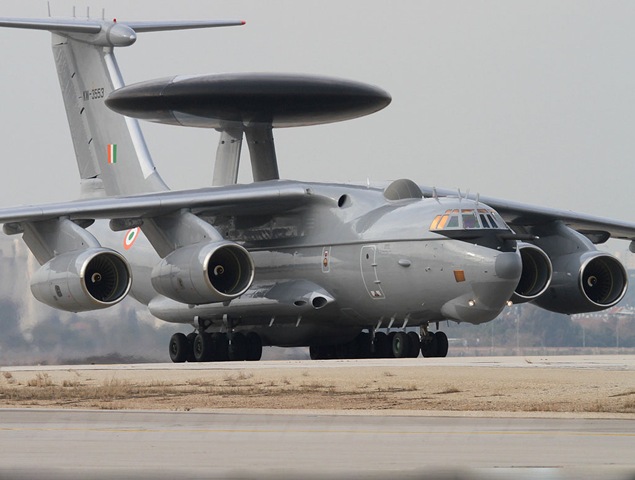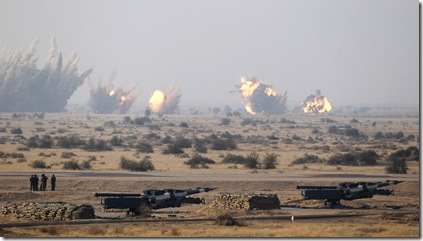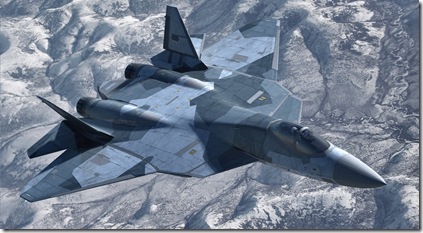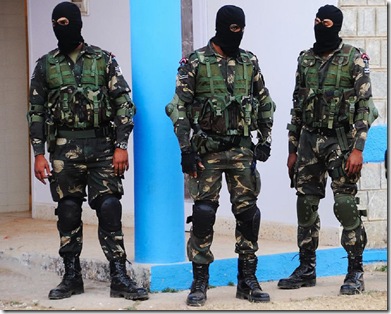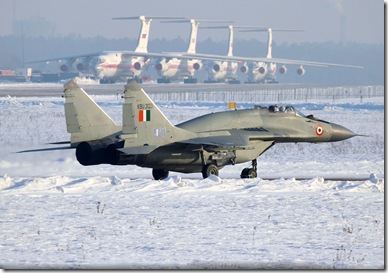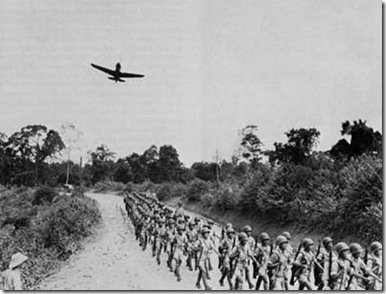Security of Indian airspace is the responsibility of Indian Airforce (IAF). The president serves are Commander in Chief IAF. Indian Air Force has a strength of 127,000 active personnel with estimates of around 1,370 aircraft in active service during 2012/2013. Here are 30 Amazing Facts About Indian Air Force.
1-5
1. Indian Air Force ranks as the fourth best operational airforce in the world. Pictured above are Army soldiers watching as target is being destroyed during the Indian Air Force (IAF) fire power demonstration exercise “Iron Fist 2013″ in Pokhran, Rajasthan February 22, 2013. The IAF displayed its operational capabilities during this exercise.
2. Indian Airforce was established on 8 October 1932 as an auxiliary air force of the British Empire. The prefix Royal was added in 1945 in recognition of its services during World War II. After India achieved independence from the United Kingdom in 1947, the Royal Indian Air Force served the Dominion of India, with the prefix “Royal” being dropped when India became a republic in 1950.
3. Hindustan Aeronautics Limited that was formed in 1948 is currently the largest defense firm in public sector.
4. October 8th of every year is celebrated as the Indian Air force Day.
5. Apart from Indian Wars, IAF also saw significant conflict in 1960, when Belgium’s 75-year rule over Congo ceased abruptly, engulfing the nation in widespread violence and rebellion. Squadron No. 5 was sent to support United Nations Operation in the Congo. The unit remained there until 1966, when the UN mission ended. Operating from two bases, IAF destroyed the rebel Air Force and provided the UN ground forces with its only long-range air support force.
6-10
6. Indian Airforce Currently Operates 3 Beriev A-50 Phalcon AEW&C (Airborne early warning and control) aircrafts(pictured above), around 700 fighters, 7 aerial refueling tanker aircrafts, 133 transport aircrafts, 158 trainer aircrafts, 33 attack helicopters, 156 transport helicopters, 155 utility helicopters, about 200 UAVs.
7. The list of aircrafts that have been ordered and yet to be added to the force are 2 Beriev A-50 Phalcon AEW&C (Airborne early warning and control) aircrafts, 3 EMB-145 AEW&C (DRDO Indian-Made), 172 fighters, 15 transport aircrafts, 360 trainer aircrafts, 22 attacks helicopters, 171 transport helicopters and 65 utility helicopters. Apart from these most of the old fleet of fighters are being modernized to current standards.
8. The Indian Air Force’s primary air superiority fighter is the Sukhoi Su-30MKI, which is among the most elite fighter jets in the world alongside the Eurofighter Typhoon, Dassault Rafale and USAF’s best F-series of fighters.
9. The Sukhoi Su-30MKI, Dassault Mirage 2000, and MiG-29 serve in the Indian Air Force and are also seen as a means to deliver nuclear weapons.
10. In addition India maintains SEPECAT Jaguar and MiG-27M which can be used to drop gravity bombs.
11-15
11. Modernization: The 5th generation Sukhoi PAK FA (pictured above) under development with Russia will be the most lethal fighter jet in the world alongside the F-22 and is expected to start flying around 2015. To add to the above list, Airborne Early Warning (AEW) aircrafts have also been acquired from Israel and are being developed indigenously too. India has also acquired 6 C-130J Super Hercules aircraft for its special forces and will likely order some more from the United States. C-17 Globemaster heavy-lift aircrafts are also likely to be acquired shortly, which will take India’s defense cooperation with the US to a new level.
12. The new in queue for the indigenous aircraft of India is HAL-Tejas. The Tejas had received the Initial Operation Clearance (IOC) in Jan,2011. Two squadrons (~40 aircraft ) would be raised and based at Coimbatore by 2013. It integrates technologies such as relaxed static stability, fly-by-wire flight control system, multi-mode radar, integrated digital avionics system, composite material structures, and a flat rated engine. It is a tailless, compound delta-wing design powered by a single engine.
13. Air Force Network (AFNet) is an Indian Air Force (IAF) owned, operated and managed modern, state-of-the-art, fully secure and reliable network (Intranet) and gigabyte digital information grid. The AFNet replaces the Indian Air Force’s (IAF) old communication networkset-up using the tropo-scatter technology of the 1950s making it a true net-centric combat force. he IAF project is part of the overall mission to network all three services, i.e., The Indian Army, The Indian Navy and The Indian Air Force. Defence Minister of India Shri AK Antony inaugurated the IAF’s the AFNET on 14 September 2010 dedicating it to the people of India, for their direct or indirect participation in the communication revolution.
14. The Indian Air Force has a Training Command and several training establishments. While technical and other support staff are trained at various Ground Training Schools, the pilots are trained at the Air Force Academy located at Dundigul, The Pilot Training Establishment at Allahabad, the Air Force Administrative College at Coimbatore, The School of Aviation Medicine at Bangalore, the Air Force Technical College, Bangalore at Jalahalli and the Paratrooper’s Training School at Agra are some of the other training establishments of the IAF.
15. Tendulkar is the first sportsperson to be conferred a rank by IAF and the first personality with no aviation background to receive the honour of IAF’s honorary Group Captain.
16-20
16. In September 2009, IAF established its own special operation unit called the Garud Commando Force, consisting of approximately 1500 personnel. Garud is tasked with the protection of critical aviation installations; undertaking combat search and rescue, suppression of enemy air defence, radar busting, combat control, missile and munitions guidance (“lasing” of targets) and other missions in support of air operations. They can also undertake an offensive role including raids on enemy air bases, etc., during times of war.
17. Flying Officer Nirmal Jit Singh Sekhon is the only member of the Indian Air Force to have been awarded the Param Vir Chakra, India’s highest military decoration. During the Indo-Pakistani War of 1971, Srinagar air base was attacked by six Pakistani North American F-86 Sabres. Sekhon got a Folland Gnat off the ground and engaged the Sabres. He managed to destroy two Sabres before being shot down in the dogfight. The remaining Sabres chose not to press the attack and returned to Pakistan. He was posthumously awarded the Param Vir Chakra for his single handed protection of the Srinagar air base. Nobody in the Indian Air Force has since claimed this honour.
18. Padmavathy Bandopadhyay was the first woman Air Marshal of Indian Air Force. She was the Director General Medical Services (Air) at the Air Headquarters. She had the distinction of being the first woman officer to become an aviation medicine specialist. Padma Bandopadhyay was awarded the Visisht Seva Medal for her meritorious service during the 1971 Indo-Pak conflict. She is the first woman Fellow of the Aerospace Medical Society of India and the first Indian woman to have conducted scientific research at the North Pole. She is also the first woman officer to have completed the Defence Service Staff College course in 1978 and to command the IAF’s Central Medical Establishment (CME). Padma Bandopadhyay was also the first woman officer of the Indian Air Force to be promoted to the rank of Air Vice Marshal.
19. Air Marshal Sir Thomas Walker Elmhirst was the first Commander-in-Chief of the Indian Air Force. He was Air Chief from 15 August 1947 to 21 February 1950. It was Air Marshal Elmhirst’s insistence that the Indian Air Force became an independent service under no control of the Army. Before independence of India, the Commander-in-Chief of the Indian Army exercised control over the Air Force too. Thus, it was Air Marshal Thomas Walker Elmhirst’s foresight that led to the independent status of IAF. Air Marshal Elmhirst was also instrumental in turning an incomplete air force into a cohesive fighting machine.
20. Air Marshal Subroto Mukherjee was the first Indian Chief of Air Staff of Indian Air Force. He was Air Chief from 1 April 1954 to 8 November 1960.
21-25
21. In the Kargil War, the IAF rapidly adapted to the air campaign’s unique operational challenges, which included enemy positions at elevations of 14,000 to 18,000 feet, a stark backdrop of rocks and snow that made for uncommonly difficult visual target acquisition, and a restriction against crossing the Line of Control that forms the border with Pakistan. The IAF code-named its contribution to the campaign Operation Safed Sagar— Hindi for “white sea.”
22. An Integrated Space Cell has been set up by GOI to utilize more effectively the country’s space-based assets for military purposes and to look into threats to these assets. The Integrated Space Cell is controlled by the three defence services as well as civilian agencies dealing with space. The armed forces are increasingly depending on satellites for communication, aircraft and missile guidance, reconnaissance and surveillance. Satellites are also essential for civilian purposes such as weather forecasting, disaster management and communications. This has made it important to work out measures to protect India’s space-based assets.
23. Some cool facts about the Apache helicopters IAF is all set to acquire. The radar-equipped AH-64D Apache Longbow has longer-range weapons accuracy and all-weather/night fighting, claims Boeing. According to Boeing the AH-64D Apache Longbow is capable of classifying and threat-prioritization of up to 128 targets in less than a minute. Boeing claims that the helicopters boast of integrated sensors, networking, and digital communications for situational awareness, management of the combat arena in real time, and digital transmission of images and target locations to joint operations battlefield commanders. Fitted with air-to-air missiles, an Apache helicopter has the capability to take on enemy choppers and UAV, providing support to ground troops. With its array of modern electronics, Apache is considered to be one of the most advanced combat helicopters capable of detecting 256 moving targets and engaging them.
24. At its peak IAF operated about 224 squadrons with about 18 abandoned since then.
25. Even after losing precious lives of 171 pilots, 39 civilians and eight persons from other services, we are using second generation Mig-21 fighter plane and sending our talented pilots to their untimely death in these ‘flying coffins’ and ‘widow-maker’.
26-30
26. An important factor which many analysts and defence experts believe could have altered the outcome of Indo-Chinese War of 1962 was India’s decision of not using the air force. The Indian Air Force (IAF) was not used for any offensive action and was only confined to air dropping supplies to the troops. Former Air Vice-Marshal A K Tewary, in an article in Indian Defence Review, said that had India pressed in the IAF, the outcome of the war would have been different. He blamed the IB Director B N Mullick for exaggerated assessment of attack by Chinese bombers on Indian cities if India had used the air force.
27. In Indo-Pakistan War of 1965 for the first time in its history, the Indian Air Force (IAF) had to contest command of the air against a highly trained Pakistan Air Force (PAF) equipped with aircraft and weapons systems technologically far superior to those of the IAF, courtesy the United States. Even given the tactical edge and element of surprise, PAF failed to capitalize and IAF came out victorious. The PAF was losing aircraft at nearly three times the rate of the IAF during the war.
28. In the 1965 Indo-Pak war Squadron Leader Devayya of IAF in his Mystere shot down a Starfighter flown by Flight Leutinent A. Hussain War. Mystere was a Mach-1 fighter that was at least a generation obsolete than the Starfighter (Mach 2).
29. The Atlantique Incident (1999): The Shooting down of the Pakistani Navy Atlantique was the first peace time incident ever that an Aircraft violating Indian Air Space was shot down. It involved the most serious loss of life ever in a single incident for the Pakistani Navy for the first time since the 1971 War. It is till date, the only occasion when an aircraft that belonged to a Heavy transport/Surveillance category has been shot down. All the previous IAF Air Combat kills were against Fighter aircraft.
30. Surya Kiran is an aerobatics demonstration team of the Indian Air Force. The team has a total of 13 pilots and operates 9 HAL HJT-16 Kiran Mk.2 trainer aircraft painted in an orange and white colour scheme. Sarang is the Helicopter Display Team of the Indian Air Force. This team flies four HAL Dhruvs painted in red and white with a peacock figure at each side of the fuselage.

















